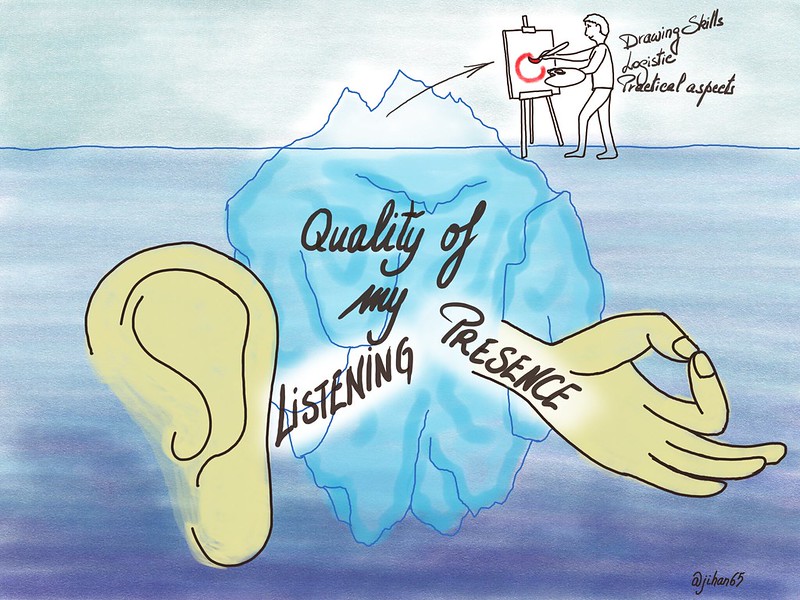In this second post on the same topic, I will deepen my answer to the question “How to start with an empty blank page when taking live visual notes?”
In my previous post “How to use space in graphic notes“, I explain what you can do to prepare yourself before an event to feel more comfortable with the practice of taking visual notes.
Much before the drawing skills, the logistic, and before any other practical aspect, what will really influence the outcome of your work is the quality of your presence and the quality of your listening.
Quality of your presence
You really need to be fully present when taking live visual notes at an event. Firstly, this means that you have to be connected as much as possible with all of “you”, with who and with what you are. Simplifying it a little bit, you need to access both sides of your brain and let them work together. Or – I prefer to say it like that – let the two sides of your brain “make love” in you. You need also to be connected with the surrounding world. This last point seems obvious but if your focus is on the choice of the marker’s color or on your space consumption on the paper sheet….you risk to not being connected with what is happening around you, and with what is said.
What is said? What is really said and what do I hear?
Quality of your listening
Like with traditional text notes, how you listen and to what you listen will bring you to very different results. Except that with visuals, the difference will be felt even more than with just text.
I recommend the following material from experts to know more about “Listening”:
http://www.coachwiththegreenhat.com/listening-is-good-for-you-four-steps-to-mastering-active-listening/
A better presence and a better listening
The quality of both your presence and your listening will greatly influence your ability to take visual notes and, finally, your outcomes. Therefore it is worth to prepare yourself a minimum before you start. Some minutes before you jump on your markers, take the time to do some exercises of meditation, or mindfulness, or yoga, or relaxation. Whatever can help you is welcome. And if nothing comes to you, just try to close your eyes, breathe slowly and deeply, and have at least 10 of these breaths.
Last but not least…
The more you will practice, the better!
My last recommendation is to start to practice as soon as possible, then to practice and to practice again.
I would like to conclude with two quotes. First is this Pablo Picasso’s answer to the question whether ideas come to him “by chance or by design”:
“I don’t have a clue. Ideas are simply starting points. I can rarely set them down as they come to my mind. As soon as I start to work, others well up in my pen. To know what you’re going to draw, you have to begin drawing… When I find myself facing a blank page, that’s always going through my head. What I capture in spite of myself interests me more than my own ideas.”
Then – to keep you from believing that the Picasso’s reference implies that we treat art here – this Mike Rohde‘s quote applicable to all visual notes in general:
“Sketchnotes are about capturing and sharing ideas, not art. Even bad drawings can convey good ideas.”
Related post: “How to use space in graphic notes”


2 Replies to “To know what you’re going to draw, you have to begin drawing”
Comments are closed.